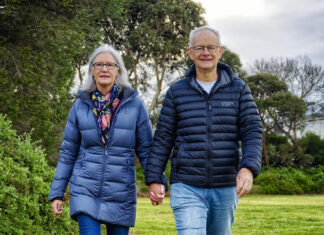By NOEL MURPHY
INVISIBILITY cloaks might make for magic Harry Potter entertainment but for Deakin University’s Tiffany Walsh and the US Air Force they’re deadly serious business.
Together, they’re working on nanotechnology techniques to camouflage fighter planes from attack.
And taking inspiration from natural substances such as mother-of-pearl – with its unusual sheen – they’re bending light about at the molecular level so that what you might see isn’t really what’s there.
Think smoke and mirrors of 19th century magic shows brought into the 21st century and you’re almost there. Except what’s happening has much more serious military hardware and civilian applications.
Associate Professor Walsh is working with US researchers at the universities of Miami and Buffalo, with Air Force Officer for Scientific Research (AFOSR) funding, looking at manipulating light so that aircraft might be rendered effectively invisible to the enemy.
“It’s pretty ambitious and just one application this technology could potentially be used for,” Associate Professor Walsh told the Independent.
“The US Air Force made a call for proposals to make 3D assemblies of nanoparticles using bio-molecules and one potential outcome would be light bending.
“Another is photonic circuitry to carry electricity using beams of light instead of wires, exerting our technology to make it bend around corners.”
The possibility of energy being transferred by light holds enormous heat-reduced carbon footprint ramifications but as Associate Professor Walsh says, it all “might be a long way off yet”.
Even so, the peculiar 3D molecular makeup of the abalone shell’s calcium carbonate holds similarities to the nanoparticle engineering Deakin’s Institute for Frontier Materials is working on at Waurn Ponds.
“We predict the structure of these nanoparticles and bio-molecules at the molecular level and use that information to design new molecules and new ways of connecting nanoparticles, taking inspiration from nature,” said Associate Professor Walsh.
Also heavily involved in the project is the Victorian Life Sciences Computation Initiative’s super-computer, which is crucial to Associate Professor Walsh’s research. It was in fact a key determinant in drawing the Cambridge/Oxford-educated Warrnambool woman back to Australia to work in Geelong.
Even so, she’s still a regular globe-trotter, meeting regularly with US researchers.
“I talk on Skype with some of them every day, it’s very important to share ideas and discuss ideas, and sometimes you need to do so in person as well,” she said.
“And like any kind grant body, the AFOSR reviews our progress to check it’s spending its money wisely and that we’re delivering what they want.
“The team that reviews our progress is very good too, they can give us important feedback.”







